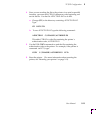
5
TCP/IP Configuration
5-18
Network Utilities for Phaser Color Printers
Setting your printerÕs IP address
There are two methods to accomplish these printer conÞguration steps:
■ Server-based printer configuration. This method uses RARP
(Reverse Address Resolution Protocol) or BOOTP (Boot Parameter
Protocol). When turned on or reset, the printer receives its IP
addressing information from a boot server.
■ Printer-based printer configuration. This method can be used on
hosts that do not have RARP or BOOTP. You store the IP
addressing information in the printerÕs internal memory, where
the printer reads it when reset.
Setting your printerÕs IP address using RARP or BOOTP (server-based
configuration)
With this method, conÞguration information is sent to the printer over the
Ethernet connection via RARP or BOOTP, depending on which protocol
your host supports.
The advantage of server-based conÞguration is that it provides centralized
administration. You can conÞgure a number of printers from a central
location. The disadvantage is that if the server is down, the printer will not
appear on the network after a reset or power cycle, because the printer gets
its boot information from a boot server and does not retain it in non-volatile
memory.
You store the printerÕs conÞguration information in a conÞguration Þle such
as an ethers or bootptab Þle on a boot server. On power up, the printer issues
RARP and BOOTP requests and receives the conÞguration information from
the server in the RARP or BOOTP response.
The RARP and BOOTP responses contain only network address
information. After the printer has its address information, you can set other
TCP/IP parameters by sending PostScript Þles to the printer using your host
spooler. Shell scripts for creating the PostScript Þles are provided on the
UNIX version of the printerÕs network utilities diskettes.


















